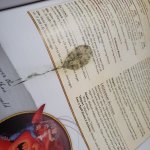Moloch (MToF)
Way back in February, I mentioned my copy of MotM had a printing error on the Moloch page.

Quite annoying I must say.
Anyway, Moloch is a deposed Archdevil, who was kicked out of the 9 Hells, for the crime of trying to overthrow Asmodeus. Every time he enters the plane, he is demoted to an imp, and cannot regain his powers until he leaves. As such, he spends most of his time elsewhere (notably in Sigil). Plotting and bargaining with what little scraps of information and power he has left in the hopes to amass another army and take back “his” realm of Malbolge, which is currently under the control of Glasya. While he still has cultists and minions, they are few and far between.
Meaning, if you ever need a desperate Archdevil to make a pact or bargain that is theoretically less beneficial for the Archdevil than a normal contract, Moloch has you covered.
In combat, Moloch is a legendary CR 21, meaning he can still pose some threat to your party. His multiattack has a selection of different elemental damage types to get around resistances, his Many-Tailed Whip can pull targets closer from a short distance (handy for traps, or even just doing a quick drag and drop). Breath of Despair is a short range AoE that inflicts a strong, long-lasting, fear. Moloch has a fair selection of control spells.
Wall of Fire and
Stinking Cloud, in particular, pair well with the dragging ability of his whip. But it is worth noting that ALL of his spells require concentration, so only one of them can be up at a time. He also has the ability to teleport 120’ as an action, should the need arise. And combined with his natural regeneration, getting away for a few rounds might just be the thing he needs for a second wind.
Moloch’s legendary actions pull from his pool of actions, either an attack, a spell (be mindful of the aforementioned concentration), or his teleport. Moloch has no lair to speak of anymore, so no lair actions.
In the Changeover, Moloch had elemental damage types appended to his attacks (due to the loss of the Magical Weapons ability). He also lost all of his not-castable-in-combat spells, along with his AoE fire spells, which were not replaced by an attack, surprisingly. A shame to be sure, as some ranged attacks would have covered the gaps in his combat prowess.




